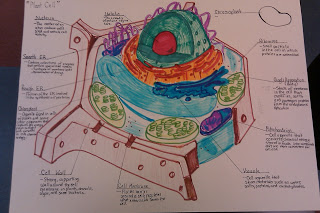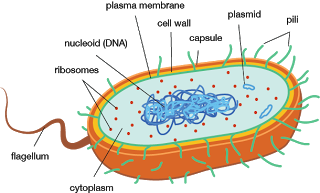Biology

b. Which 3 organelles are present in plant cells but not in animal cells? LIST them and write down their function.
- Prokaryote V.s. Eukaryote Paragraphs
Alexandra RodenNovember 18, 2014Period 3Prokaryote v.s. EukaryoteCells are the basic unit of life as we know it. There are two main categories of cells, Prokaryote and Eukaryote. Both kinds have similarities as well as drastic differences.Both categories...
- Prokaryotes Versus Eukaryotes
Cell Webquest ? Ms. Carter Prokaryotes versus Eukaryotes California Standard: Cell Biology 1. c Cell Biology: The fundamental life processes of plants and animals depend on a variety of chemical reactions that occur in specialized areas of the organism?s...
- #2.1. Cell Structure - Syllabus 2015
? The microscope in cell studies ? Cells as the basic units of living organisms ? Detailed structure of typical animal and plant cells, as seen using the electron microscope ? Outline functions of organelles in plant and animal cells ? Characteristics...
- Orgin Of Eukaryotes
News feature article on the Orgin of Eukaryotes Cells BREAKING NEWS: We have discovered the ancestors of the eukaryote cells. The Eukaryotic cells wasn't the earliest form of cell, but originated from it's ancestor the prokaryotic cells. There...
- Prokaryotic Cells Vs. Eukaryotic Cells
Prokaryotic Cells Prokaryote is a cell or an organism that lacks a nucleus and other membrane enclosed organelles and most of their DNA is a single circular molecule. All bacteria are prokaryotic cells. The word "prokaryote" means "before the nucleus"...
Biology
CELLS WEBQUEST - BIOLOGY
TYPES OF CELL WEBQUEST
CALIFORNIA STANDARD
CELL BIOLOGY
1. The fundamental life processes of plants and animals depend on a variety of chemical reactions that occur in specialized areas of the organism?s cells. As a basis for understanding this concept:
c. Students know how prokaryotic cells, eukaryotic cells (including those from plants and animals), differ in complexity and general structure.
TASKS / OBJECTIVES:
1. Know the differences and similarities between prokaryotic and eukaryotic cells
2. Prokaryotic cells:
a. Be able to draw and label the parts of a prokaryote cell
b. Identify the parts of a prokaryotic cell and know their functions
c. Give examples of prokaryotic cells
3. Eukaryotic cells:
a. Be able to draw and label the parts of an ANIMAL eukaryote cell
i. Identify the organelles of an ANIMAL cell and know their functions
ii. Give examples of animal eukaryote cells
b. Be able to draw and label the parts of a PLANT cell and know their functions
i. Identify the organelles of an PLANT eukaryote cell
ii. Give examples of plant eukaryote cells
TIME FRAME: Three days
MATERIALS: Your textbook, Internet access, paper, writing tools, color pencils
INTRODUCTION:
Look at your hand (yes, LOOK at your hand). Now, touch it (yes, TOUCH your hand). DO IT. Feel the skin under your fingers? Have you EVER wonder?
1. What is the material that makes up my skin called?
2. What is it made up of?
3. Why does it hurt or bleed when it is injured?
4. Why does it heal and how does it happen?
5. How do I grow? How did I become the person I am today from the embryo that grew up inside my mother?s womb?
The answers to all these questions: CELLS
1. CELLS are the smallest units of LIFE that make up living things.
2. ALL living things are made up of cells
3. UNICELLULAR organisms: 1 cell only
4. MULTICELLULAR organisms: more than 1 cell (guess how many cells you have).
There are two main types of cells: prokaryotes (very primitive and simple) and eukaryote (more modern and complex).
Your task is to develop an understanding of each one of these two types of cells J
PROKARYOTES versus EUKARYOTES
http://www.phschool.com/science/biology_place/biocoach/cells/common.html
http://www.cod.edu/people/faculty/fancher/prokeuk.htm (ONLY READ UNTIL POINT #5)
1. What does ?Karyose? mean and how does it relate to PROKARYOTE and EUKARYOTE (give me their definitions)?
2. What is one very important difference between prokaryotes and eukaryotes?
3. LIST 5 similarities between prokaryotes and eukaryotes
4. LIST 5 things that are different between prokaryotes and eukaryotes
PROKARYOTES
Watch this video carefully before you start your assignment http://www.brainpop.com/science/cellularlifeandgenetics/cells/
Watch this video carefully before you start your assignment http://www.brainpop.com/science/cellularlifeandgenetics/cells/
http://biology--dev.about.com/od/cellanatomy/ss/prokaryotes.htm
http://www.cellsalive.com/cells/bactcell.htm
http://ibiosas.wikispaces.com/Cells
1. Use one of the three sites above (or other of your choice) to DRAW and LABEL a prokaryote cell:
a. Label the following: capsule, cell wall, cytoplasm, NUCLEOID (they don?t have nucleus), plasma membrane, ribosomes, flagella, pili.


b. LIST their names and write their functions (what do they do?): capsule, cell wall, cytoplasm, plasma membrane, ribosomes, flagella, pili,
2. Give me an example of a prokaryote cell (look in your book or Internet).
EUKARYOTES (ANIMAL CELLS)
http://www.wisc-online.com/Objects/ViewObject.aspx?ID=AP11403
http://www.cellsalive.com/cells/cell_model.htm
http://biology--dev.about.com/od/cellbiology/ss/animal_cells.htm
1. Use one of these sites (or other of your choice) to DRAW and LABEL an animal eukaryote cell:
a. Label the following: plasma membrane, cytoplasm, nucleus, nucleolus, rough endoplasmic reticulum, smooth endoplasmic reticulum, Golgi apparatus (complex), ribosomes, mitochondrion


b. LIST and write their functions (9 total)
EUKARYOTES (PLANT CELLS)
http://www.cellsalive.com/cells/cell_model.htm
http://www.enchantedlearning.com/subjects/plants/cell/
http://www.diffen.com/difference/Animal_Cell_vs_Plant_Cell
1. Use one of these sites (or other of your choice) to DRAW and LABEL a plant eukaryote cell:
a. Label the following: plasma membrane, cell wall cytoplasm, nucleus, nucleolus, rough endoplasmic reticulum, smooth endoplasmic reticulum, Golgi apparatus (complex), ribosomes, mitochondrion, chloroplast, vacuole.

b. Which 3 organelles are present in plant cells but not in animal cells? LIST them and write down their function.
- Prokaryote V.s. Eukaryote Paragraphs
Alexandra RodenNovember 18, 2014Period 3Prokaryote v.s. EukaryoteCells are the basic unit of life as we know it. There are two main categories of cells, Prokaryote and Eukaryote. Both kinds have similarities as well as drastic differences.Both categories...
- Prokaryotes Versus Eukaryotes
Cell Webquest ? Ms. Carter Prokaryotes versus Eukaryotes California Standard: Cell Biology 1. c Cell Biology: The fundamental life processes of plants and animals depend on a variety of chemical reactions that occur in specialized areas of the organism?s...
- #2.1. Cell Structure - Syllabus 2015
? The microscope in cell studies ? Cells as the basic units of living organisms ? Detailed structure of typical animal and plant cells, as seen using the electron microscope ? Outline functions of organelles in plant and animal cells ? Characteristics...
- Orgin Of Eukaryotes
News feature article on the Orgin of Eukaryotes Cells BREAKING NEWS: We have discovered the ancestors of the eukaryote cells. The Eukaryotic cells wasn't the earliest form of cell, but originated from it's ancestor the prokaryotic cells. There...
- Prokaryotic Cells Vs. Eukaryotic Cells
Prokaryotic Cells Prokaryote is a cell or an organism that lacks a nucleus and other membrane enclosed organelles and most of their DNA is a single circular molecule. All bacteria are prokaryotic cells. The word "prokaryote" means "before the nucleus"...
